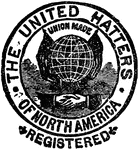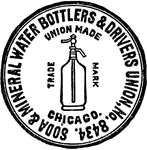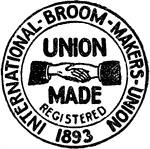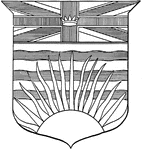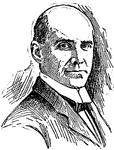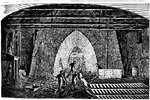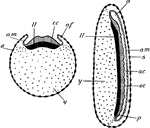
Insect Embryo
"A transverse section before the union of the amnion folds, and a longitudinal median section after…

Stomach
The digestive system. This figure represents the whole tract of the intestinal canal, not exactly in…

Axillary
"Axillary.--Placed in the axilla (arm-pit). A term by which the angle formed by the union of the leaf…

George Gordon Meade
(1815-1872) American soldier in the Mexican War and Union general in the Civil War.
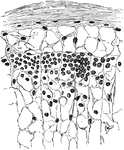
Section of the Lymphatic Gland Showing the Adenoid Reticulumn
Adenoid or retiform tissue consists of a very delicate network of minute fibrils, formed originally…
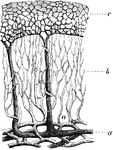
Blood Vessels of the Stomach
Plan of the blood vessels of the stomach, as they would be seen in a vertical section. Labels: a, arteries,…
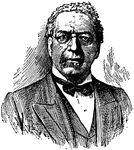
Samuel Gompers
(1850-1924) "An American labor leader, one of the founders and the first president of the American Federation…

Fire engine pump
The ordinary fire-engine is formed by the union of two forcing-pumps which play into a common reservoir,…
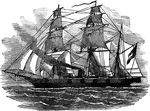
The Alabama
The Alabama was a Confederate man-of-war built by the British. It served as a commerce raider attacking…
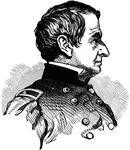
Robert Anderson
Robert Anderson was an American military leader. He served as a Union Army officer in the American Civil…

Gratiot Street Prison
The Gratiot Street Prison was an American Civil War prison located in St. Louis, Missouri and was the…

"Burnside Bridge," Antietam Creek
The bridge played a key role in the September 1862 Battle of Antietam during the American Civil War…

Atlanta, Georgia in 1874
An illustration of Atlanta, Georgia as depicted in 1874. Atlanta, GA is the capital and the most populous…

Nathaniel Prentiss Banks
He was an American politician and soldier, served as Governor of Massachusetts, Speaker of the U.S.…

Marine Hospital
The United States Marine Hospital is a historic Greek Revival hospital building in Mobile, Alabama.…

Bartholdi's Statue of Liberty in New York Harbor
Liberty Enlightening the World, commonly known as the Statue of Liberty, was presented to the United…
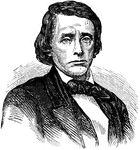
William Gannaway Brownlow
William Gannaway Brownlow was Governor of Tennessee from 1865 to 1869 and a Senator from Tennessee from…
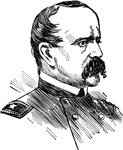
Daniel Butterfield
Daniel Adams Butterfield (October 31, 1831 – July 17, 1901) was a New York businessman, a Union General…
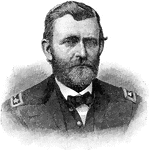
Ulysses S. Grant
Ulysses S. Grant, born Hiram Ulysses Grant (April 27, 1822 – July 23, 1885), was an American general…

Edward Richard Sprigg Canby
Edward Richard Sprigg Canby (November 9, 1817 – April 11, 1873) was a career United States Army…

Archbishop Thomas Cranmer
Thomas Cranmer (2 July 1489 – 21 March 1556) was a leader of the English Reformation and Archbishop…

Battle of Chickamauga
The Battle of Chickamauga, fought September 18-20, 1863, marked the end of a Union offensive in south-central…

Battle of Cold Harbor
The Battle of Cold Harbor, the final battle of Union Lt. Gen. Ulysses S. Grant's 1864 Overland Campaign…
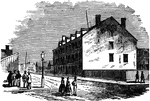
Castle Thunder
Castle Thunder, located in Richmond, Virginia, was a former tobacco warehouse located on Tobacco Row,…

Samuel Wylie Crawford
Samuel Wylie Crawford (November 8, 1829 - November 3, 1892) was a United States Army surgeon and a Union…

Fort Donelson
Fort Donelson and Fort Heiman, two sites of the American Civil War Forts Henry and Donelson Campaign,…
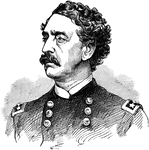
Abner Doubleday
Abner Doubleday (June 26, 1819 – January 26, 1893) was a career United States Army officer and…
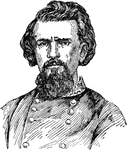
Nathan Bedford Forrest
Nathan Bedford Forrest (July 13, 1821 – October 29, 1877) was a lieutenant general in the Confederate…

William Buel Franklin
William Buel Franklin (February 27, 1823 – March 8, 1903) was a career United States Army officer…
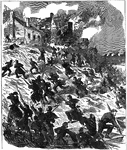
The Attack on Fredericksburg
The Battle of Fredericksburg, fought in and around Fredericksburg, Virginia, from December 11 to December…
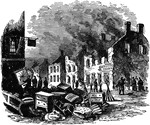
Scene in Fredericksburg on the Morning of Dec. 12, 1862
The Battle of Fredericksburg, fought in and around Fredericksburg, Virginia, from December 11 to December…
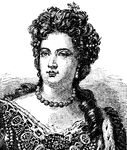
Queen Anne of Great Britain
Anne (6 February 1665 – 1 August 1714) became Queen of England, Scotland and Ireland on 8 March…

Battleground of Little Round Top
Little Round Top is the smaller of two rocky hills south of Gettysburg, Pennsylvania. It was the site…
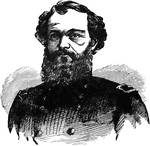
Quincy Adams Gillmore
Quincy Adams Gillmore (February 25, 1825 - April 11, 1888) was an American civil engineer, author, and…

Walter Quinton Gresham
Walter Quintin Gresham (March 17, 1832 - May 28, 1895) was an American statesman and jurist.

Foote's Gunboat Flotilla in 1862
USS Pittsburgh (1861) was a City class ironclad gunboat constructed for the Union Navy during…
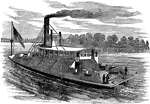
The New Era
USS New Era (1862) was a steamer acquired by the Union Navy during the American Civil War.…
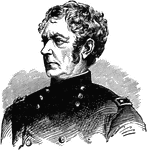
Joseph Hooker
Joseph Hooker (November 13, 1814 - October 31, 1879) was a career United States Army officer, fought…
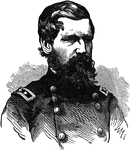
Oliver Otis Howard During the Civil War
Oliver Otis Howard (November 8, 1830 - October 26, 1909) was a career United States Army officer and…
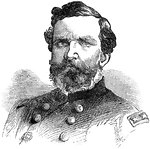
George Henry Thomas
George Henry Thomas (July 31, 1816 – March 28, 1870) was a career United States Army officer and…
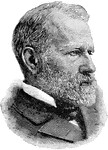
Benjamin Franklin Tracy
Benjamin Franklin Tracy (April 26, 1830 – August 6, 1915) was a United States political figure…
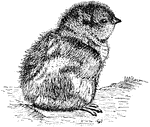
Young Grouse
Grouse are a group of birds from the order Galliformes. Often considered a family Tetraonidae, the American…
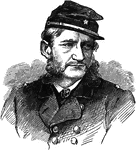
Hugh Judson Kilpatrick
Hugh Judson Kilpatrick (January 14, 1836 – December 4, 1881) was an officer in the Union Army…
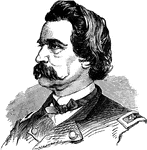
John Alexander Logan
John Alexander Logan (February 8, 1826 – December 26, 1886) was an American soldier and political…

A Union Device
"Unite or Die." This snake device first appeared when the Stamp Act excitement was at its height.

Stephen Van Rensselaer
Stephen Van Rensselaer III (November 1, 1765 – January 26, 1839) was Lieutenant Governor of New York…

Vicksburg during the Civil War
The Vicksburg Campaign was a series of maneuvers and battles in the Western Theater of the American…

Porter's Fleet Shelling the Batteries Vicksburg
Union forces bombarded the city all night, from 220 artillery pieces and naval gunfire from Rear Adm.…

Cave Life in Vicksburg
During the siege, Union gunboats lobbed over 22,000 shells into the town and army artillery fire was…
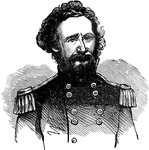
Nathaniel Lyon
Nathaniel Lyon (July 14, 1818 – August 10, 1861) was the first Union general to be killed in the…
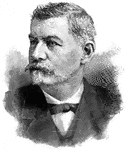
Major-General George B. McClellan
George Brinton McClellan (December 3, 1826 – October 29, 1885) was a major general during the…
